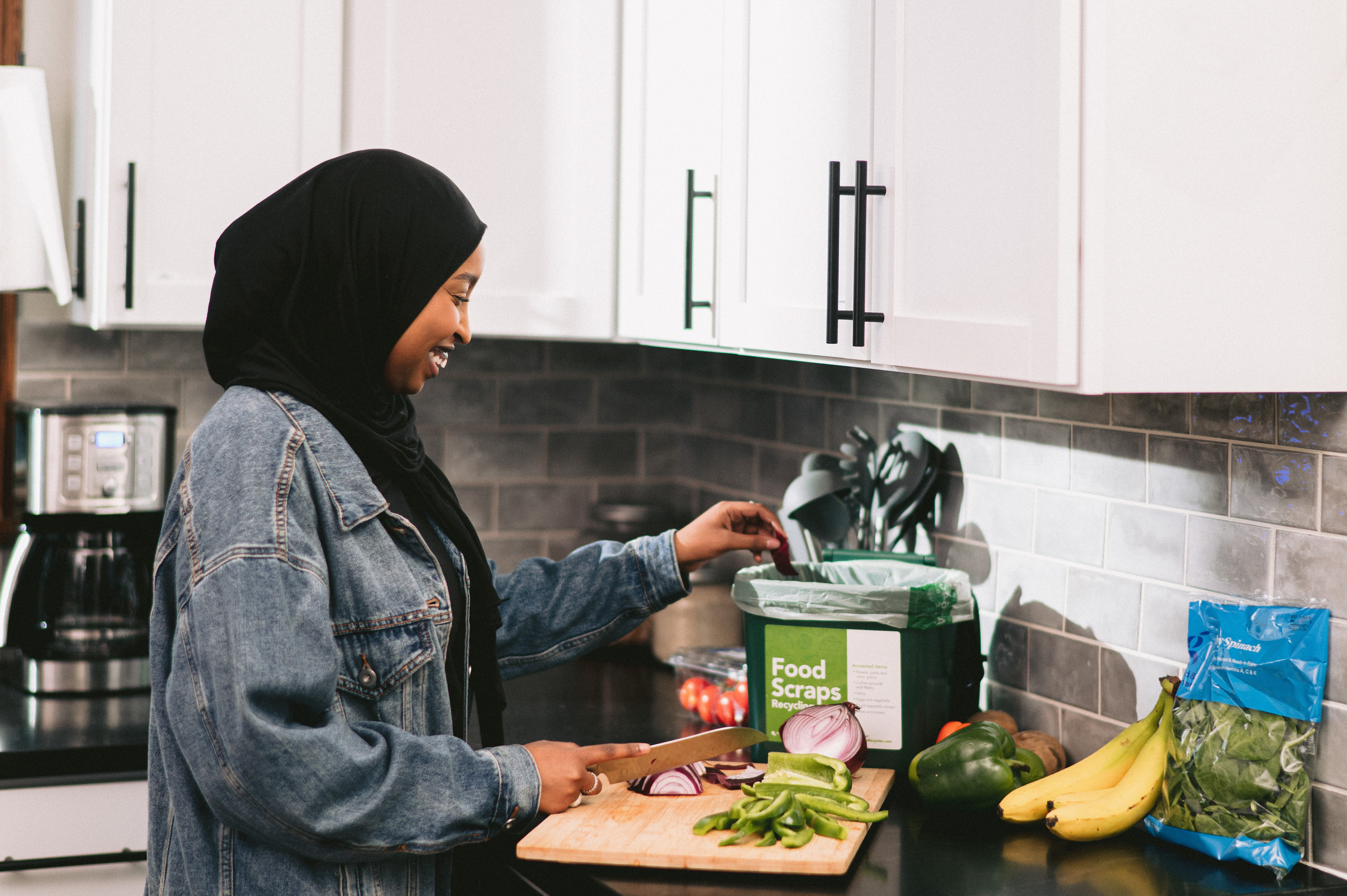How to start collecting food scraps

Food scraps make up nearly twenty percent of trash in Minnesota. Fruit peels, coffee grounds and eggshells are just a few examples of food that gets thrown away. Food scraps recycling is one solution that breaks down food scraps into compost used in gardens, landscaping and construction projects. When compost is added to soil, it can help the soil hold more water and nutrients, support more living organisms and help control erosion and stormwater runoff. Even if you don’t have a backyard, you can still participate in this process and reduce the amount of food going in the trash.
Step 1: Figure out what works for you.
Take stock of what supplies you have and what type of home you live in. If you have a backyard, you can start your own backyard composting system with a compost bin, pitchfork and water hose. If you can’t compost in your backyard or live in an apartment, you can collect food scraps and bring them to a Ramsey County collection site for free. You can also see if your apartment facility has a composting system in place, or if they are willing to start one. There are many ways to recycle food scraps. Do what works best for you!
Step 2: Gather your supplies.
Based on your set-up, there are a few different items you may need and/or want for your collection process. If composting in your yard, follow the Minnesota Pollution Control Agency’s “Composting in your backyard” tips. If collecting food scraps and dropping them off at a collection site, think about what type of collection method will work for you. To start, you will need to pick up BPI certified compostable bags at either a Ramsey County food scraps collection site for free or buy your own – no plastic bags! There are many ways to collect food scraps.
To better preserve food scraps, place them in a freezer-proof bag or container and store in the freezer until ready to be dropped off at a food scraps collection site. Be sure to remove food scraps from any plastic bags and transfer them to a BPI certified compostable bag before dropping them off.
Use a garbage bin or a spare plastic storage big with a lid to store both the BPI certified compostable bag and food scraps. You can choose the size of the container based on the amount of food scraps your household produces.
Collect food scraps in an ice cream bucket or similar-sized container with a lid to store food scraps in smaller spaces, such as under the kitchen counter. Line the bucket with a BPI certified compostable bag.
You could also buy a container specifically made to store food scraps. There are lots of retail options with a wide price range.
Be creative and find what works for you!
3. Start collecting!
Once you have compostable bags and a method to store food scraps, it’s time to start collecting!
If composting in a backyard bin at home, it’s recommended to compost the following:
- Plant material including small amounts of leaves and grass clippings (leave out weeds that have gone to seed).
- Food scraps (except meat, bones, grease and dairy).
- Coffee grounds and coffee filters.
- Soiled paper and paper products, like dirty napkins, paper plates and paper egg cartons.
*Do not add compostable plastics. They will not break down in a backyard compost bin.
If bringing food scraps to a Ramsey County collection site, you can drop off the following items (no yard waste):
- Food scraps, including bones, coffee grounds and paper filters, dairy products, eggshells, fish, grease, meat and seafood, moldy or expired food and sauces. For a complete list, visit our Food Scraps page.
- BPI certified compostable items.
- Non-recyclable paper, including paper towels, food-stained paper bags, napkins and paper egg cartons.
4. Remember the golden rule.
When in doubt, keep it out. If you aren’t sure if an item is compostable and you can’t find the answer on our website, it’s best practice to keep the item out of the food scraps collection bin and put it in the trash instead. Otherwise, you could potentially contaminate your food scraps collection and make it unable to be composted.
5. Reduce food waste.
Collecting food scraps for compost is a great way to reduce the amount of food that goes in the trash. Another important habit is to reduce the amount of food wasted. Before grocery shopping, check what food you already have in your pantry and refrigerator to make sure you don’t purchase items you already have. Another option is to freeze leftovers and other foods to extend their lifetimes. Learn more about food saving tips.
To track your food waste and learn more about preventing waste, participate in the Minnesota Pollution Control Agency’s five-week-long Reduce Your Wasted Food Challenge. This self-guided challenge can be taken at any time and provides many activities, tips and tricks to reduce food waste.